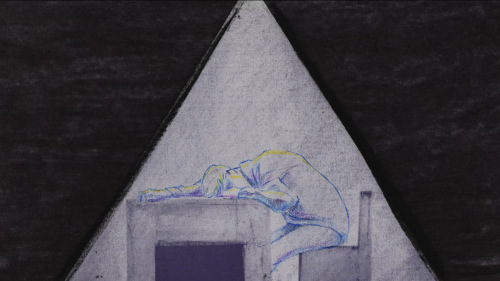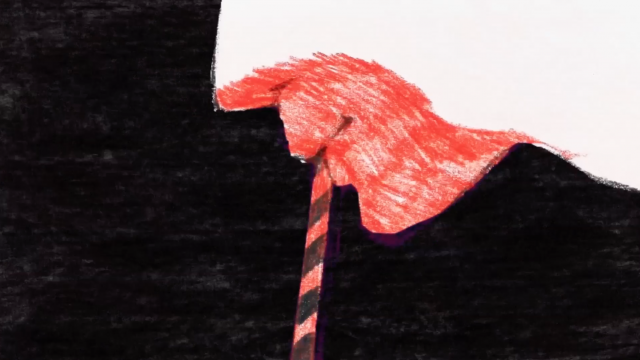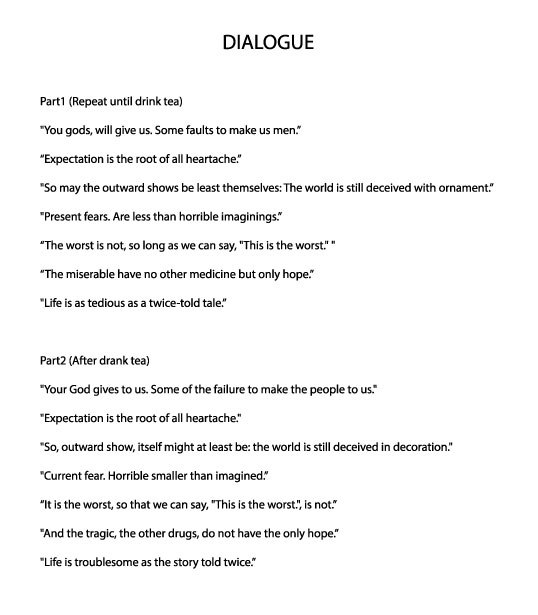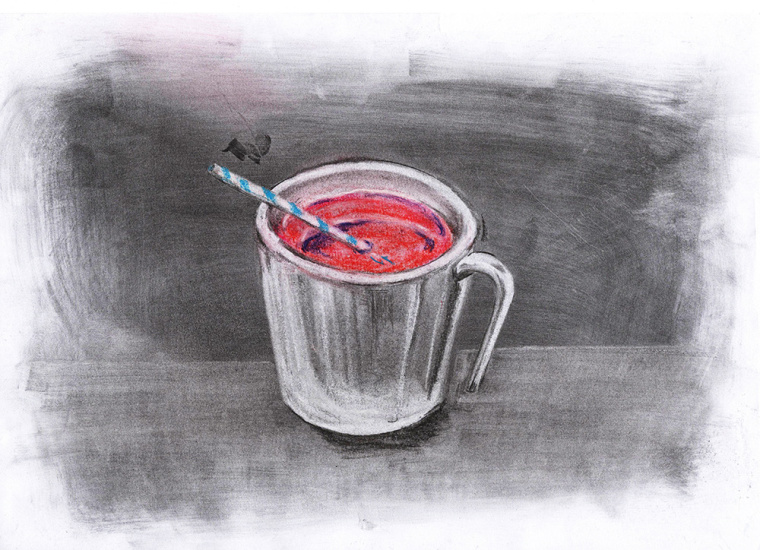The multi-talented filmmaker discusses her latest acclaimed film, and the life experiences that inspired it.

Noriko Ishibe is a Japan-born and London-based filmmaker currently finishing up her BA in animation at the University for the Creative Arts in Farnham. Skilled in many animation techniques involving both physical and digital tools, Noriko has produced an impressive array of work, all leading up to the unique two-minute short Tea With a Straw, which aired at last month’s Jam Session.
Tea With a Straw puts Noriko’s own experiences moving from Japan to England into a colorful and somewhat mysterious context; in the 2 minutes, 20 seconds short, we see a man wake up in front of a table with a cup of tea served to him with a straw. In the first half of the short, we hear the haunting sounds of Shakespeare quotes (voiced by Sven Mattes) spoken calmly in voiceover. Then, once the unnamed subject drinks the tea through the straw, not only do other events begin to escalate around him, but the same Shakespeare quotes are repeated, but this time with strange variations.
It was interesting to learn that, in fact, the first set of these quotes was taken by Noriko and put through Google Translate - into Japanese and then back into English - to create the disorienting sort of slightly erroneous English that the app usually creates when trying to translate word-for-word. I have done the same before, both for fun and to see what certain things - often my own writings - sound like when processed and re-processed by the automatic translator. This is, however, the first time I’ve seen it used as a filmmaking technique, and it’s both a fascinating and eerie thing to experience.
The excellent sound design (by Riley Wong), combined with Noriko’s stunning hand-drawn animation (and unique use of color), make for a heavily re-watchable 2-minute short, one that provides more and more texture with every viewing. In using a unique approach to forming the concept, its director has made an introspective expression of the obstacles she faced dealing with the language barrier after her move that is, at the same time, a bold statement of intent. I caught up with Noriko recently to discuss her animation background and the production of Tea With a Straw.
When did you first start animating?
At primary school, doodling in the corner. And then [later] in school, I self-taught in stop-motion animation, but I always had a strong complex for drawing.
How have you grown as an animator since then?
I think since I’ve come [to London], I’ve been doodling a lot. When I was in Japan, I [felt that] I needed to draw more perfectly, but now I’ve stopped thinking about good or bad, or correct. It’s a different drawing skill, it’s more natural.

How do the Japanese and UK film communities compare?
Japan has a massive community, anime, which is like a fandom. It’s very strong, like the Hollywood film community. But compared with the UK, in Japan short animation, such as I’ve been making here, it’s not as popular.
How have both countries influenced your work?
I tend to express my experience - when I got to the UK, my daily life, that is my theme. So gender complexity, the language barrier, how I chat and drink beer at the pub rather than just enjoy the food, and how men are always nice to the women. A lot of feminists here.
It’s very different about gender equality. Here, women are higher [motions with hands, creating a comparison of the equality levels; for the UK it’s equal] but Japan is here [moves the hand representing women far lower]. It’s getting closer, but not the same as here.
Who are some animators who have inspired and influenced your work?
Hayao Miyazaki. When I was little, I was inspired by watching Kiki’s Delivery Service every night. I’ve watched it 300 times over. He draws the Japanese spirit. When I was little, I don’t know what I got from the film, but I think I got what animation is based on from Hayao Miyazaki. His style is the basis for my style.
And do you know Jan Švankmajer? He’s a Czech animator who makes stop motion animation, and his works are always dark and surreal and show a strong message, even though at the time he worked the Czech Republic was much regulated by the Soviet Union.
Also Marcus Armitage, who was a few years ago a BAFTA-nominated director and then graduated from the Royal College of Art and I helped him on his film My Dad. When I worked with him, he had an eager attitude and motivation to his work that influenced me so much. And he enjoyed being crazy; I admire him [for that].

Going on to “Tea with a Straw”, I’m really interested in the Google Translate technique you used, where for the dialogue you translated Shakespeare quotes into Japanese and back.
I was not good at writing English, so I always struggled, and sometimes I needed to cheat for my writing, or needed to check my grammar by Google Translate. And I checked [the Shakespeare quotes in Google Translate], and it didn’t make any sense at all.
The result is a bit funny, and so I got the idea from that.
Why Shakespeare quotes?
I was walking with a group, and [realized] I needed to research about Shakespeare. You know, Shakespeare’s the British thing, and I was interested in his [work] a lot, and so I picked up quotes from his scripts, and I made a paragraph from different ones.
In Japan, we also study Shakespeare, but we study it in Japanese, so this connects it a bit. [Original and post-Google Translate dialogue below, find out more here.]

What were the techniques you used to animate the film?
For materials, I used charcoal and colored pencils. Colored pencils I always use; I like to use them. The charcoal was inspired by the painter William Kentridge; he always uses charcoal. His works are always a bit tired, which mirrors the feeling of my Tea with a Straw. And I like raw materials, which is why I used charcoal and colored pencils.
You’ve used many other forms of animation, such as stop motion and digital - how do they compare to this?
This is more convenient. And [often] when I made a stop motion, I used food, and when I use food, like chocolate, I need to care about the food - is it gonna be rotten, will I need to eat something? I don’t want to get chubby [laughs].
This film was made at a very important moment for you, emotionally. Since you made the film, how have you changed?
Writing or speaking English, technically, became better last year, after I made the film. But I think to communicate with people - from books or dramas, I can get the feeling of the culture or the background of the people, and I can absorb them, and that’s gonna make me more natural. That makes a more natural shape of me.

What are you working on right now?
A graduation film. It’s called Boats on the Grassland. It’s about culture shock, culture difference, and it’s gonna be a very weird film, I can say. It’ll be hand drawn, with charcoal as well, and I’m gonna try painting [the backgrounds].
Do you have any favorite recent films?
I watch a lot, but recently I haven’t had any time, but I’ve seen Carol, a very beautiful Cate Blanchett film. It was very good lesbian story, with a lot of humanity. And The Martian, I liked that.
Find out more about Noriko’s work on her website, norikoishibe.com.


